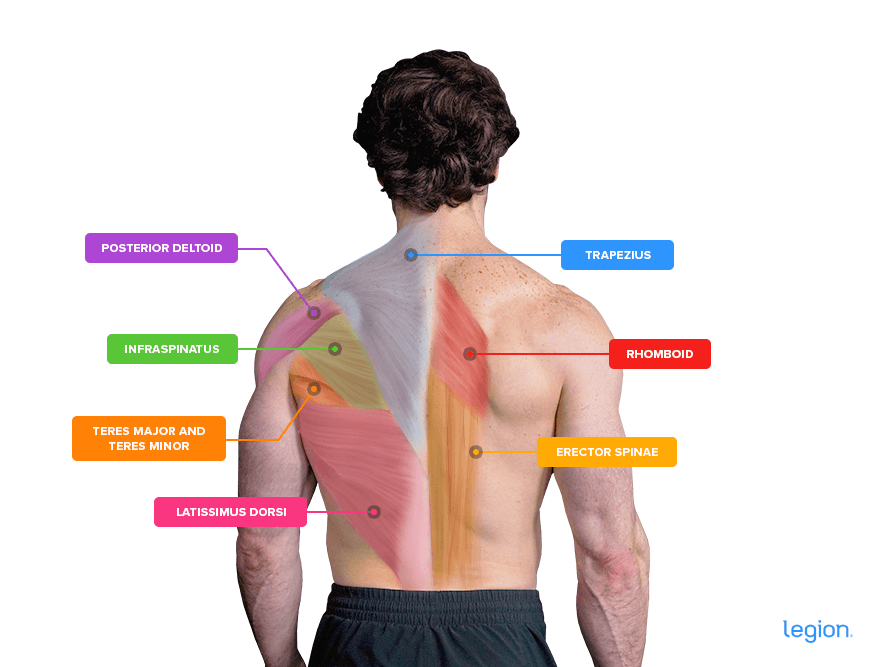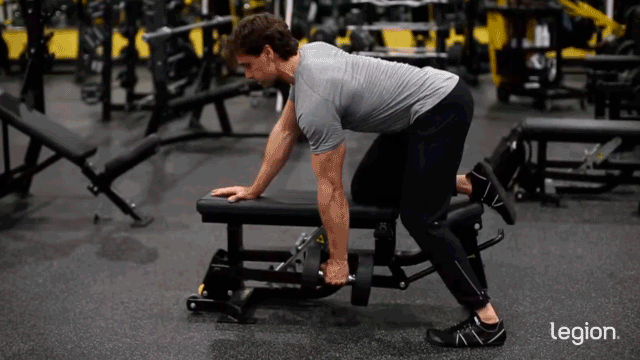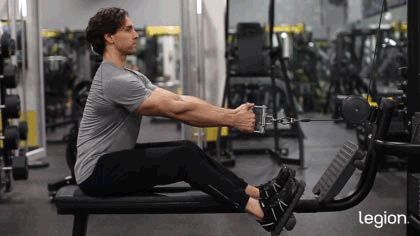The Kroc row is a dumbbell back exercise created by world-record-holding powerlifter and bodybuilder Matthew Kroczaleski.
It’s similar to the regular dumbbell row, except it allows you to use less strict form to lift heavier weights for higher reps.
That’s not to say it’s a “sloppy” one-arm dumbbell row. Instead, it involves intelligently using momentum to compensate for your body’s natural weakness so you can build more mass and strength.
In this article, you’ll learn how to do Kroc rows, why they’re effective, the difference between Kroc rows and regular dumbbell rows, some effective alternatives, and more.
How to Do Kroc Rows
To master Kroc row form, split the exercise into three parts: set up, row, and descend.
1. Set up
Hold a dumbbell in your right hand. If you’re using weightlifting straps, ensure the strap is tightly wound around the handle and lying comfortably around your wrist.
Stand behind an adjustable weight bench set at a 15-to-30-degree angle, place your left hand on the top of the bench, and then move your right foot slightly back for stability.
Lean forward until your back is at a 45-degree angle relative to the floor, bend your knees slightly, flatten your back, and allow your right arm to hang straight down and your right shoulder blade to fully protract (move toward the floor).
2. Row
Extend your hips (thrust them forward slightly) to get the weight moving, and then pull your elbow toward the ceiling. Squeeze your shoulder blades together and keep your spine flat and neutral as you lift the weight.
Continue pulling until the weight touches the bottom of your rib cage.
3. Descend
Reverse the movement and return to the starting position. At the bottom of the rep, let the dumbbell pull your shoulder down until you feel a deep stretch in your lats and upper back muscles.
Once you’ve completed the desired number of reps, repeat the process with your left side to complete one set.
For even more guidance, check out this video of Matt Kroc performing the Kroc row:
Muscles Worked by Kroc Rows
The main muscles worked by Kroc rows are:
- Latissimus dorsi (lats)
- Trapezius (traps)
- Rhomboids
- Teres major and minor
- Posterior deltoids (rear delts)
- Infraspinatus
- Erector spinae
It also trains your biceps and forearms to a lesser extent.
Here’s how these muscles look on your body (sans the biceps and forearms):

Kroc Rows vs. Dumbbell Rows: Benefits and Drawbacks
The dumbbell row and Kroc row share many benefits. For instance, both allow you to train your entire back with heavy weights, so they’re excellent exercises for gaining mass and strength.
Additionally, both train your back unilaterally (one side at a time), so they enable you to lift more total weight than you can with some bilateral exercises (exercises that train both sides of the body simultaneously), which may help you gain more muscle over time.
Because they’re unilateral, they can also help you establish a stronger mind-muscle connection, fix muscle and strength imbalances, and enhance athletic performance more than bilateral exercises.
The main difference between the two exercises is that Kroc rows involve more momentum. In most scenarios, using momentum to lift more weight is inadvisable, but with dumbbell row variations, it can be advantageous.
That’s because they have an unusual “resistance curve:” They feel easiest at the bottom of each rep when you’re strongest, and hardest at the top when you’re weakest. This can make it difficult to finish reps, even when the rest of the rep feels easy.
The problem is that people often end their sets when they can’t complete the last few inches of the range of motion, even though their back muscles are still relatively fresh, and this leaves gains on the table.
Kroc rows help you avoid this issue. By incorporating some controlled momentum, they enable you to train through the entire range of motion, ensuring your back muscles receive a strong signal to grow.
That’s not to say the Kroc row is better than the dumbbell row.
Kroc rows require more coordination and practice, so they’re not ideal for beginners. People are also more prone to using sloppy form on Kroc rows, which can stress your joints and soft tissues, increasing the risk of injury.
With this in mind, it’s generally best to start with regular dumbbell rows when you’re new to weightlifting. As you become more experienced, you can incorporate Kroc rows into your program.
From there, you can either stick with the variation you prefer or alternate between the exercises every 8-to-10 weeks.
Sets and Reps for the Kroc Row
Matt Kroc had a particular way of programming Kroc rows. Specifically, he did them once per week as part of his back or pull workout immediately after deadlifts.
He performed 2-to-4 warm-up sets with progressively heavier weights, then one “top” set with as much weight as possible, aiming to hit a new weight or rep record in every workout.
In this top set, he aimed for at least 20 reps and increased the weight once he could do more than 25 reps with both arms. He also rested 2-to-3 minutes between the top sets for his right and left sides.
Many people copy this approach and see good results, so it’s a viable option. The downside is that it takes significantly longer than a more conventional set and rep scheme once you factor in the warming up and resting.
A more practical approach is to perform 3-to-4 sets of 10-to-12 reps, resting 3-to-4 minutes between sets. To save time, do Kroc rows after a compound pulling exercise like deadlifts or pull-ups, as this will ensure your back is already warmed up and ready for the exercise.
The Best Kroc Row Alternatives
1. One-Arm Dumbbell Row

The one-arm dumbbell row trains your back similarly to the Kroc row. The difference is that the regular dumbbell row is easier to learn and less likely to stress your joints and soft tissues. Since you can brace your knee on a bench for extra support, it’s also gentler on your lower back.
2. Meadows Row

If your gym doesn’t have heavy enough dumbbells to continue progressing on the Kroc row, the Meadows row is an excellent alternative. Because it involves a barbell, it has a much higher loading potential, so you can continue progressing for longer.
3. Seated Cable Row

Unlike the Kroc row, the seated cable row trains both sides of your body simultaneously. However, similar to the Kroc row, it allows you to move your upper body forward and backward. This means you can lean forward to stretch your upper back and lats at the bottom of each rep, and then “whip” your torso backward to create momentum, helping you power through the “sticking point.”
Scientific References +
- Jakobi, Jennifer M., and Philip D. Chilibeck. “Bilateral and Unilateral Contractions: Possible Differences in Maximal Voluntary Force.” Canadian Journal of Applied Physiology, vol. 26, no. 1, Feb. 2001, pp. 12–33, https://doi.org/10.1139/h01-002.
- Janzen, Cora L., et al. “The Effect of Unilateral and Bilateral Strength Training on the Bilateral Deficit and Lean Tissue Mass in Post-Menopausal Women.” European Journal of Applied Physiology, vol. 97, no. 3, 28 Mar. 2006, pp. 253–260, https://doi.org/10.1007/s00421-006-0165-1.
- Liao, Kai-Fang , et al. Effects of Unilateral vs. Bilateral Resistance Training Interventions on Measures of Strength, Jump, Linear and Change of Direction Speed: A Systematic Review and Meta-Analysis. Mar. 2022, www.termedia.pl/Effects-of-unilateral-vs-bilateral-resistance-training-interventions-on-measures-of-strength-jump-linear-and-change-of-direction-speed-a-systematic-review-and-meta-analysis,78,44423,0,1.html.










